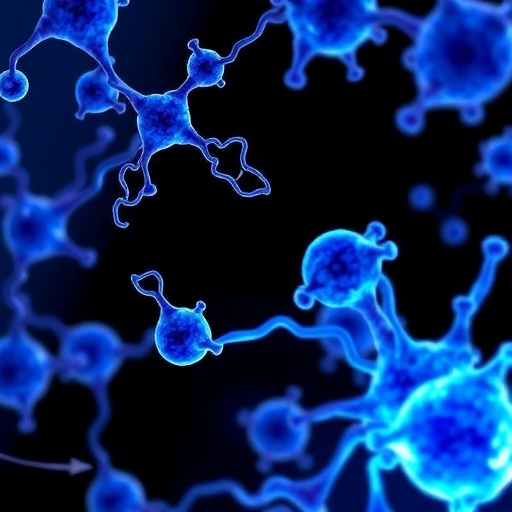In a groundbreaking study poised to reshape our understanding of neurodevelopment, researchers have unveiled unprecedented insights into the intricate brain maturation processes following preterm birth. The research, recently published in Nature Communications, offers a deeply nuanced picture of how the brains of individuals born prematurely evolve over time, revealing a complex interplay of heterogeneity, temporal consistency, and neural plasticity. This study marks a significant leap forward in neonatal neuroscience, bringing to light mechanisms that could pave the way for improved interventions and long-term outcomes for preterm infants.
Premature birth, defined as delivery before 37 weeks of gestation, complicates neurodevelopment with consequences that often persist into childhood and beyond. For decades, scientists have wrestled with understanding how early arrival outside the womb alters the brain’s trajectory—does it simply lag behind, or does it follow an altogether different path? By deploying advanced longitudinal neuroimaging techniques combined with computational modeling, the authors have disentangled this conundrum, revealing that preterm brains exhibit a distinct developmental signature rather than mere delayed maturation. This nuanced characterization challenges longstanding assumptions about uniform developmental delays, suggesting that diverse brain regions undergo temporally unique yet sustained patterns of change.
Fundamental to the study’s findings is the concept of heterogeneity in brain development post-preterm birth. The research team meticulously traced cortical and subcortical brain structures over multiple time points, employing state-of-the-art magnetic resonance imaging modalities that capture subtle microstructural and morphological variations. Results highlighted that rather than a global uniform deficit, specific brain regions exhibited varied developmental trajectories: some areas showed accelerated growth, while others lagged behind or exhibited atypical morphological patterns. This spatially heterogeneous development underscores the importance of moving beyond coarse assessments toward region-specific evaluations for better prognostic accuracy.
Temporal consistency emerged as another vital attribute of brain maturation observed in the study. Despite the diverse trajectories across regions, the developmental patterns were remarkably stable and predictable over extended postnatal periods. This temporal coherence suggests intrinsic biological programs governing the brain’s response to premature birth, which remain robust despite external environmental influences. The authors leveraged longitudinal data stretching from infancy into adolescence, confirming that these patterns were not transient artifacts but rather enduring developmental motifs, which hold promise for early identification of at-risk individuals.
Perhaps most strikingly, the research uncovers compelling evidence of neural plasticity—the brain’s capacity to adapt and reorganize itself—after preterm birth. Plasticity manifested in dynamic shifts in structural connectivity and cortical thickness, signaling ongoing remodeling processes that could be harnessed therapeutically. The findings indicate that, although early-life disruptions perturb typical development, critical windows remain open for intervention. Recognizing the existence and timing of these plastic phases opens avenues for targeted cognitive and motor training regimens aimed at optimizing neurodevelopmental outcomes.
To achieve these revelations, the investigators integrated multi-modal imaging data with sophisticated machine learning algorithms capable of detecting subtle yet meaningful developmental signals. Such computational power allowed for the identification of latent patterns invisible to traditional analytic approaches. Their models differentiated not only age-specific brain alterations but also individual variability, emphasizing personalized developmental trajectories rather than homogenous group-level averages. This methodological innovation represents a notable step towards precision medicine in neonatal care.
The implications of heterogeneous and temporally consistent brain changes are profound for clinical practice. Neonatal intensive care units currently rely on generalized developmental metrics that may overlook critical region-specific vulnerabilities. The study’s detailed mapping of brain regions prone to alteration enables clinicians to refine monitoring approaches and tailor neuroprotective strategies accordingly. Early detection facilitated by this research can inform decisions on therapeutic timing, intensity, and modality, ultimately improving quality of life for preterm individuals.
Moreover, the elucidation of plasticity mechanisms invites renewed optimism about intervention efficacy. Until now, many assumptions constrained expectations for brain recovery after premature birth, with a perception of irreversible damage. However, the identification of robust plastic phases suggests that appropriate cognitive and sensory enrichment, combined with pharmacological support, could catalyze favorable rewiring and functional compensation. This paradigm shift not only affects acute treatment but also long-term educational and rehabilitative frameworks necessary for maximizing developmental potential.
From a biological standpoint, the study sheds light on the interplay of genetic, epigenetic, and environmental factors that sculpt postnatal brain development in preterm neonates. The authors postulate that heterogeneous regional vulnerabilities may result from differing maturational timelines and varying exposure to stressors such as hypoxia or inflammation. By integrating clinical metadata with imaging findings, the research contextualizes neurodevelopment within a dynamic biopsychosocial model. Future investigations expanding on these interactions could unravel causal pathways and identify biomarkers for individualized prognostication.
The study also emphasizes the critical importance of longitudinal follow-up into adolescence and beyond. Many previous investigations have been limited to infancy or early childhood, missing ongoing developmental nuances. By extending observations across a broader temporal window, this research captures the evolving nature of brain changes, highlighting phases of vulnerability and resilience that evolve with age. Such comprehensive monitoring is essential for designing interventions that align with the brain’s shifting plasticity landscapes.
In terms of technology, the researchers’ utilization of advanced diffusion tensor imaging (DTI) and volumetric analyses allowed for exceptional resolution of white matter pathways and cortical structures. These high-fidelity imaging modalities, combined with repeated measurements over time, provided an unprecedented dataset for dissecting developmental dynamics. Coupled with machine learning’s predictive capabilities, the approach represents a model for future neurodevelopmental studies seeking to decode complex maturation patterns.
Despite the remarkable advances, the authors note limitations such as potential confounding by environmental variations across study participants and the challenges of controlling for myriad neonatal complications. Nonetheless, the robustness of temporal consistency across heterogeneous samples underscores the biological validity of findings. Future work incorporating larger cohorts and multi-center designs will be vital for generalizability and for integrating multifactorial influences such as socioeconomic status and parental care.
The societal implications of this study are equally compelling. Preterm birth rates continue to rise worldwide, and the burden of neurodevelopmental disorders attributable to prematurity imposes significant emotional, financial, and healthcare challenges. By delineating clearer developmental profiles and identifying critical periods of intervention potential, this research offers hope for reducing disparities and improving life trajectories. Policymakers and healthcare providers may harness these insights to prioritize resource allocation for early childhood development programs.
Importantly, the study also raises ethical considerations around prognostication and parental counseling. As nuanced biomarkers become available for predicting neurodevelopmental outcomes, care must be taken to balance accurate information with supportive guidance. Understanding the plastic and temporally stable nature of brain development post-preterm birth provides a more hopeful framework that can be communicated to families, emphasizing potential rather than deficits.
In conclusion, this landmark research presents a sophisticated portrait of brain development after premature birth, characterized by spatial heterogeneity, temporal stability, and remarkable plasticity. By leveraging cutting-edge imaging and analytic tools, the authors have decoded patterns that redefine neurodevelopmental trajectories and open new horizons for clinical care and scientific inquiry. The study not only advances foundational neuroscience but offers tangible pathways toward improving outcomes for one of the most vulnerable populations—preterm infants. As the field builds upon these insights, the hope is that every prematurely born child can achieve their fullest cognitive and functional potential through timely, personalized intervention.
Subject of Research: Brain development patterns following preterm birth, focusing on heterogeneity, temporal consistency, and neuroplasticity.
Article Title: Heterogeneous, temporally consistent, and plastic brain development after preterm birth.
Article References:
Thalhammer, M., Seidlitz, J., Neubauer, A. et al. Heterogeneous, temporally consistent, and plastic brain development after preterm birth. Nat Commun 16, 8269 (2025). https://doi.org/10.1038/s41467-025-63967-1
Image Credits: AI Generated




